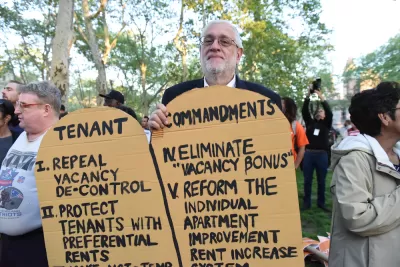Voters in six Bay Area cities in four Bay Area counties will determine the outcome of eight ballot measures on rent and eviction control. Two of the cities will have city council-sponsored measures competing against voter initiatives.

From an economist's perspective, rent control is a loser. That's the thrust of a comprehensive piece on Bay Area rent and eviction control ballot measures by Kathleen Pender, San Francisco Chronicle business columnist (as well as a Planetizen blog post last year by Michael Lewyn).
Pender presents surveys and studies that back-up that perspective. The onus of maintaining affordability for regulated buildings is placed on landlords and newer tenants without doing anything to address the greater problem, lack of housing supply.
At the same time, it's easy to understand why these measures get on the ballot in the Bay Area.
Since 2010, the average asking rent for units of all sizes in the nine-county Bay Area has risen by roughly $1,000, or 66 percent, to $2,504, according to Novato research firm Real Answers.
And then there are the egregious examples of rent increases and evictions that occur in many of the region's communities. For example, the plight of a 97-year-old Burlingame resident (see 'Measure R' below) served a 60-day eviction notice after living in her rental for 66 years was reported in the Daily Mail (United Kingdom) on Feb. 24. On March 6, the paper reported she died.
What's particularly helpful is that Pender explains California legislation that places limits on the protections that ballot measures can seek.
For example, renters living in 21-year old or newer apartment buildings "and all single-family home and condos" can not be protected by rent control measures per the Costa-Hawkins Rental Housing Act [PDF-Calif. Apartment Association].
It also said that when tenants voluntarily vacate a rent-controlled unit, owners can charge the next tenant market rates, but after that it becomes subject to the annual rent control limit.
However, all rentals, regardless of age and building type, are not exempt from eviction control measures placed on the ballot, allowing "cities to limit evictions to specified just causes, including those allowed under a 1985 law known as the Ellis Act," writes Pender, though some of the below measures "also exempt single-family homes and newer condos from eviction controls."
- Alameda County [PDF]: Alameda: Measures L1, a city council initiative and M1, a voter initiative
- Oakland — Measure JJ, a city council initiative
- Contra Costa County [PDF]: Richmond — Measure L, a city council initiative
- San Mateo County: Burlingame — Measure R, voter initiative
- San Mateo — Measure Q, voter initiative
- Santa Clara County [PDF]: Mountain View — Measures V, a voter initiative, and W, a city council initiative
Pender describes the basics of each of the above ballot measures.
Related Planetizen posts:
- On the Bay Area's Peninsula: A Reborn Tenants' Rights Movement, June 13, 2016.
-
Housing Crisis Leads to Renewed Support For Rent Control, June 1, 2016
-
The Economics of Rent Control (blog), September 21, 2015
-
Reconsidering Rent Control, April 4, 2015
FULL STORY: Rent control spreading to Bay Area suburbs, to economists’ dismay

Study: Maui’s Plan to Convert Vacation Rentals to Long-Term Housing Could Cause Nearly $1 Billion Economic Loss
The plan would reduce visitor accommodation by 25,% resulting in 1,900 jobs lost.

North Texas Transit Leaders Tout Benefits of TOD for Growing Region
At a summit focused on transit-oriented development, policymakers discussed how North Texas’ expanded light rail system can serve as a tool for economic growth.

Why Should We Subsidize Public Transportation?
Many public transit agencies face financial stress due to rising costs, declining fare revenue, and declining subsidies. Transit advocates must provide a strong business case for increasing public transit funding.

How to Make US Trains Faster
Changes to boarding platforms and a switch to electric trains could improve U.S. passenger rail service without the added cost of high-speed rail.

Columbia’s Revitalized ‘Loop’ Is a Hub for Local Entrepreneurs
A focus on small businesses is helping a commercial corridor in Columbia, Missouri thrive.

Invasive Insect Threatens Minnesota’s Ash Forests
The Emerald Ash Borer is a rapidly spreading invasive pest threatening Minnesota’s ash trees, and homeowners are encouraged to plant diverse replacement species, avoid moving ash firewood, and monitor for signs of infestation.
Urban Design for Planners 1: Software Tools
This six-course series explores essential urban design concepts using open source software and equips planners with the tools they need to participate fully in the urban design process.
Planning for Universal Design
Learn the tools for implementing Universal Design in planning regulations.
City of Santa Clarita
Ascent Environmental
Institute for Housing and Urban Development Studies (IHS)
City of Grandview
Harvard GSD Executive Education
Toledo-Lucas County Plan Commissions
Salt Lake City
NYU Wagner Graduate School of Public Service





























